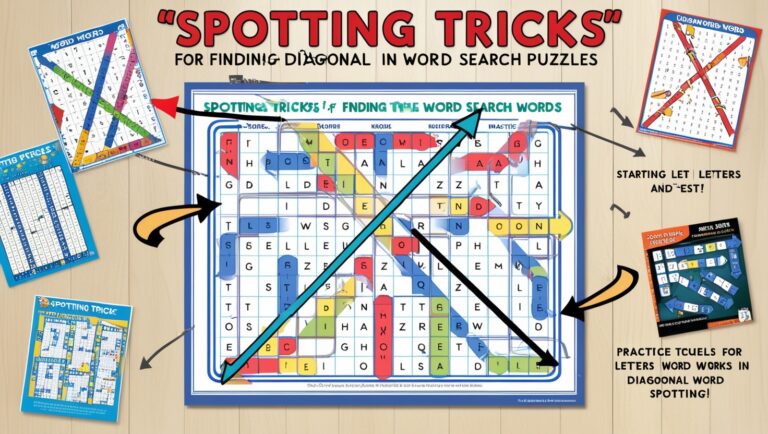From Novice to Pro. How to Crush Every Word Search Puzzle
Yo, word search warriors! Ready to level up your puzzle game from newbie to total pro? Whether you’re just starting out or looking to sharpen your skills, we’ve got the ultimate guide to help you crush every word search puzzle like a boss. Get ready to unlock some serious game-changing tips and tricks that’ll turn you into a word search legend.
Crush the Basics
First things first, let’s talk grid mastery. Getting comfy with the grid is crucial—think of it like learning the lay of the land before a big adventure. You need to know every row, column, and diagonal like the back of your hand. Familiarize yourself with how the grid is structured so you can move seamlessly across it. This knowledge will make searching for words way more efficient and less stressful.
Grid Mastery
- Row and Column Check: Practice identifying all rows and columns to become familiar with their layout.
- Diagonal Drills: Spend time searching for words diagonally to get comfortable with this direction.
- Grid Patterns: Look for common patterns in grids to improve your scanning efficiency.
Word List Game
- Prioritize Words: Highlight or mark high-priority words to find them first.
- Use Colors: Color-code your word list to visually separate different types of words.
- Cross-Referencing: Cross-reference the word list with the grid as you find each word to avoid mistakes.
Key Strategies
- Directional Focus: Develop a habit of checking words in all possible directions—forward, backward, diagonal.
- Edge Focus: Pay special attention to words that might be hidden along the edges of the grid.
- Overlap Technique: Use overlapping areas to spot multiple words at once.
Next up, your word list is your treasure map. Keep it organized and right by your side. This list is your go-to guide for tracking which words you’ve found and which ones are still hiding. An organized list helps you stay on top of your game and ensures you don’t waste time searching for words you’ve already found.
Level Up Your Scanning Skills
Time to sharpen those scanning skills! Your eyes need to move with precision so no letter slips past you. Train yourself to be detail-oriented and quick. Focus on each section of the grid, and don’t let any part go unchecked. The more practiced your scanning, the faster you’ll spot those hidden words.
Sharp Focus
- Laser Vision: Imagine your eyes are like a laser beam, focusing on one line or row at a time.
- Highlighting: Use a pen or a digital tool to highlight the lines as you scan them.
- Avoid Distractions: Make sure your scanning area is free from distractions to maintain focus.
Zone Tactics
- Create Zones: Draw imaginary lines on the grid to separate it into manageable zones.
- Sequential Scanning: Scan each zone from left to right or top to bottom for systematic searching.
- Zone Recheck: After completing a zone, recheck it briefly before moving on to ensure no words were missed.
Speed Scans
- Quick Passes: Perform quick passes over the grid to get a sense of where words might be.
- Practice with Timer: Use a timer during practice sessions to build speed and accuracy.
- Focus on Efficiency: Aim to find words without getting bogged down by minor details.
One trick to leveling up is using zone tactics. Break the grid into smaller, manageable sections and tackle each one methodically. This way, you can focus on one area at a time and avoid feeling overwhelmed by the whole grid. It’s like playing a game in stages instead of all at once.
Pattern Recognition Pro Tips
Now, let’s talk pattern recognition. This is where things get interesting. Start by spotting common letter sequences that pop up often. For example, combos like “ing” or “ed” are frequently found in words. Recognizing these sequences can give you a major edge in finding words quickly.
Letter Sequences
- Common Combos: Look for common letter sequences like “ch,” “th,” or “st” that often appear in words.
- Repeating Patterns: Identify repeating letter patterns that might indicate a word’s presence.
- Segment Search: Focus on segments of the grid where these sequences are likely to appear.
Shape Shifting
- Identify Shapes: Look for shapes or formations in the grid that resemble words you’re searching for.
- Use Diagonals: Don’t overlook diagonal word shapes; they often hide words effectively.
- Shape Memorization: Memorize common word shapes to recognize them quickly during searches.
Visual Tricks
- Highlight Shapes: Use a highlighter or visual tool to mark shapes or patterns as you spot them.
- Color Coding: Color-code the grid based on patterns or shapes to make finding words easier.
- Edge and Corner: Pay special attention to the edges and corners where patterns might stand out.
Shape shifting is another cool trick. Look for words that form specific shapes—like straight lines or zigzags—in the grid. Sometimes, words don’t follow the usual patterns, so being able to recognize different word shapes will help you uncover those tricky finds.
Supercharge Your Word Lists
Your word list is more than just a list—it’s a powerful tool for conquering puzzles. Start by organizing it. Group words by length or type to streamline your search. For instance, put all the 5-letter words together so you can hunt them down more efficiently. An organized list means a smoother search process. More information is available here.
Organize It
- Categorize Words: Group words by category (e.g., animals, countries) for easier tracking.
- Alphabetical Order: Sort words alphabetically to quickly locate specific terms.
- Use Symbols: Add symbols or icons next to words to signify their difficulty level.
Flashcard Vibes
- DIY Cards: Create your own flashcards with word lists for on-the-go practice.
- Digital Flashcards: Use apps to create digital flashcards and practice anywhere.
- Memory Games: Turn flashcards into memory games to make studying fun.
Track & Tackle
- Progress Check: Regularly check off words as you find them to monitor your progress.
- Visual Tracker: Use a visual tracker like a progress chart to see how many words you’ve found.
- Update List: Keep your list updated with any new words or terms you encounter during practice.
Flashcards are another way to supercharge your word list game. Create flashcards with the words you struggle with and review them regularly. This helps reinforce your memory and makes it easier to spot those words when you’re in the heat of the puzzle.
Time Attack Mode
Ready to push your skills to the limit? Time to activate time attack mode! Use a timer to set speed challenges for yourself. See how quickly you can complete a puzzle and try to beat your own best times. It’s a fun way to add a bit of competition and push yourself to improve.
Timer Challenges
- Set Limits: Challenge yourself with a set time limit to complete each puzzle.
- Record Times: Keep a record of your times to track improvements and set new goals.
- Challenge Friends: Have friendly time challenges with friends to add a competitive edge.
Beat Your Best
- Track Improvements: Use a tracking method to note your fastest times and aim to improve them.
- Celebrate Milestones: Celebrate when you beat your best time to stay motivated.
- Analyze Performance: Analyze what strategies worked best to improve your speed.
Frequent Practice
- Daily Puzzles: Solve a puzzle daily to maintain and improve your speed.
- Varied Difficulty: Practice with puzzles of varying difficulty to build overall speed and accuracy.
- Regular Timing: Regularly time your puzzle-solving sessions to gauge and enhance your speed.
Beating your best times is all about tracking your progress. Keep a record of how long it takes you to finish puzzles and aim to improve each time. It’s like leveling up in a game—each victory is a step towards becoming a word search pro.
Brain Power Boosters
Let’s talk brain power boosters! Start with mind mapping. Before diving into a puzzle, visualize the grid and potential word locations in your head. This mental rehearsal helps you get a head start and makes it easier to spot words as you begin your search.
Mind Mapping
- Visualize First: Before starting, visualize the grid and possible word locations to strategize.
- Mental Notes: Make mental notes of where words might appear to start searching more effectively.
- Practice Visualization: Regularly practice visualizing different grid layouts to improve spatial awareness.
Memory Tricks
- Create Associations: Use word associations or stories to remember difficult words.
- Mnemonic Devices: Apply mnemonic devices to remember word lists better.
- Practice Recall: Regularly test yourself on word recall to strengthen your memory.
Focus Drills
- Concentration Exercises: Engage in exercises designed to improve your concentration and focus.
- Mindfulness Practice: Practice mindfulness to enhance overall mental clarity and focus.
- Quick Thinking: Do quick-thinking drills to improve your ability to spot words rapidly.
Memory tricks can also give you a boost. Use mnemonic devices or creative associations to remember tricky words on your list. The better you remember words, the faster you’ll find them in the grid.
Strategic Breaks & Chill
Even the best need a break! Taking strategic breaks is crucial to keeping your mind fresh. Short, regular breaks help prevent burnout and keep your focus sharp. It’s like giving your brain a power-up so you can come back to the puzzle with renewed energy.
Mental Reset
- Short Breaks: Take short breaks every 15-20 minutes to reset your brain and maintain efficiency.
- Relaxation Techniques: Use relaxation techniques like deep breathing during breaks to clear your mind.
- Re-focus: Use breaks to refocus and return to the puzzle with a fresh perspective.
Stretching It Out
- Physical Stretching: Incorporate physical stretching or light exercise during breaks to keep your body relaxed.
- Movement Breaks: Take movement breaks to avoid stiffness and keep your energy levels up.
- Refresh Routine: Develop a refresh routine that includes stretching and quick physical activity.
Zen Focus
- Create a Calm Space: Ensure your puzzle-solving area is calm and free from distractions.
- Mindfulness Moments: Practice mindfulness techniques to enhance your focus and reduce stress.
- Single Tasking: Focus on one task at a time to improve overall concentration and efficiency.
Stretching it out during breaks keeps you physically and mentally sharp. Quick stretches or a short walk can refresh your body and mind, making you more alert when you return to the grid. Staying physically active helps maintain your overall focus and stamina.
Tech Savvy Moves
Let’s get techy! Word search apps are a great way to practice and get instant feedback. Download a few to test your skills and get real-time tips on how to improve. These apps often have built-in features to help you track your progress and refine your technique.
| Tech Tool | Description | Benefits | Examples |
| App Arsenal | Download and use word search apps for practice and feedback. | Provides interactive puzzles and performance tracking. | Word Search Puzzle, Wordament |
| Online Hints | Utilize online tools for additional hints and strategies. | Offers guidance and strategy enhancements. | Word Search Solver, Puzzle Helper |
| Tech Trends | Stay updated with the latest word search apps and features. | Keeps your game fresh with new challenges and features. | New app updates, puzzle challenges |
Online hints and tools can provide extra guidance when you’re stuck. Use these resources to get hints or learn new strategies for finding words. They can be incredibly helpful for uncovering words you might otherwise miss.
With these tips in your arsenal, you’re all set to crush every word search puzzle that comes your way. From mastering the basics to leveraging tech tools, you’ve got everything you need to become a word search pro. Keep practicing, stay sharp, and most importantly, have fun while you hunt down those hidden words!






